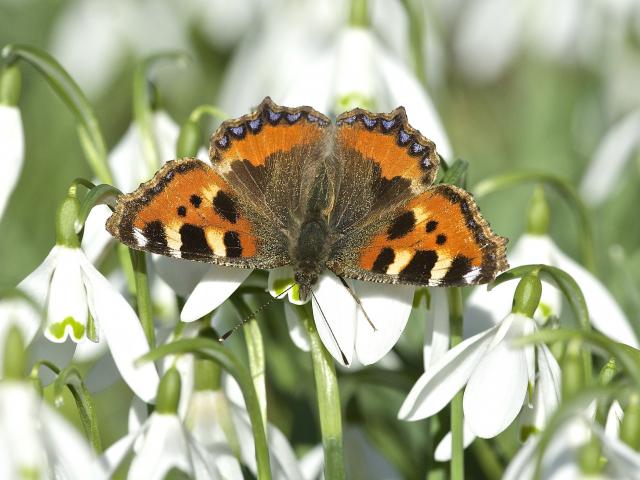The snow might have disappeared from some areas of the UK but the ground is now being carpeted with pretty white snowdrops instead. These delicate flowers are one of the earliest spring bulbs to bloom, providing a useful source of nectar for bees and butterflies such as the Red Admiral, Small Tortoiseshell and Brimstone.
Snowdrops fight through the frozen ground and lead the march out of winter and into a colourful floral spring of daffodils, bluebells and cherry blossom. They symbolise hope, rebirth and purity. One story is that to comfort Adam and Eve after their expulsion from Eden, and to bring life to the barren soil, an angel turned falling snowflakes into snowdrops.
The scientific name for Common Snowdrop Galanthus nivalis comes from the Greek – ‘gala’ meaning milk and ‘anthos’ meaning flower as the drooping bell-shaped flowers are pure white, with some green markings. ‘Nivalis’ is derived from the Latin, meaning ‘of the snow’. Other earlier common names include Fair Maids of February, White Ladies and Candlemas Bells. Candlemas Day is on 2 February and was the occasion when everyone in the parish brought their candles to church to be blessed. It also celebrated the presentation of the infant Christ in the Temple and the feast of the purification of the Blessed Virgin Mary and snowdrops would be scattered on the altar in place of her picture. Snowdrops are often found associated with churches and monastic sites.

G. nivalis is native to a large area of Europe and was probably introduced to the UK around the early 16th century. It was first recorded as being naturalised in the UK in the 1770s. There are now many snowdrop varieties, which some avid enthusiasts, known as ‘galanthophiles’, keenly collect.
Snowdrops are perennials that grow from bulbs to around 7-15cm tall, flowering from January to March. The leaves die back a few weeks after the flowers have faded.
If you want to add some to your garden this year, they are usually planted ‘in the green’ after flowering has finished but while the leaves are still present, rather than from dry bulbs. They are best planted en masse in sweeping drifts under trees or in lawns, in humus-rich soil. Once established, they will multiply and give you a larger spread each year. Let us know if you see butterflies nectaring on the swathes of snowdrops this month.
Happy Gardening!
The Secret Gardener


